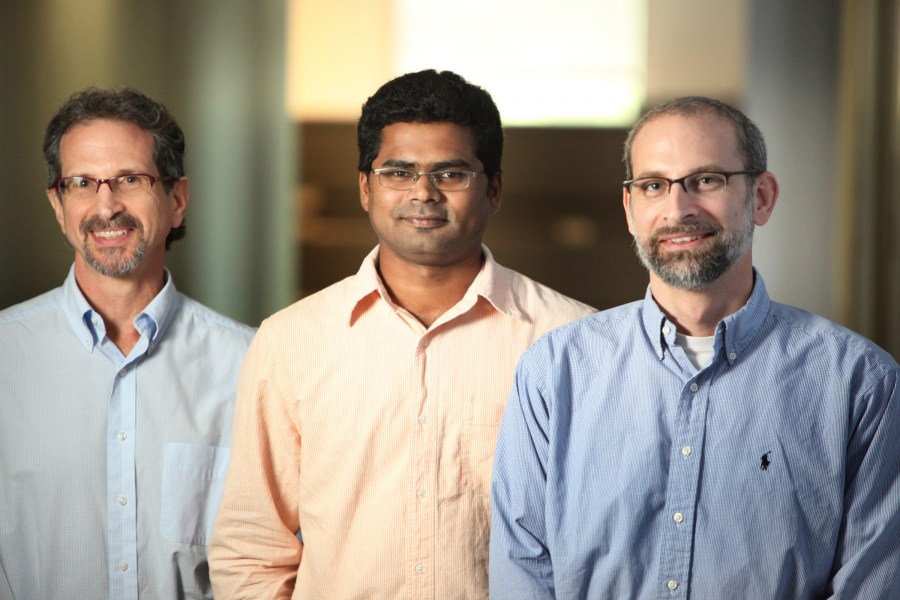
Walter Chazin, Ph.D., left, Sivaraja Vaithiyalingam, Ph.D., Brandt Eichman, Ph.D., and colleagues are studying a protein that helps get DNA replication going. (photo by Susan Urmy)
Primase structure gives insights into DNA replication
Like a lawn mower engine that needs to be “primed” before it can be started, the molecular machinery that copies DNA needs a push too.
Vanderbilt University investigators have now determined the structure of a critical piece of human DNA primase — the protein that gets DNA replication going.
The findings, reported in the Aug. 3 issue of the Proceedings of the National Academy of Sciences, provide new insights to the nuts and bolts of the DNA replication machinery. Because defects in DNA replication can lead to mutations, chromosomal instability and cancer, understanding this process at a fundamental level may impact future development of therapeutic agents for cancer and other diseases.
The primase enzyme is essential to life. While many different polymerase proteins can build new DNA — at least 15 have been identified — primase is the only protein that can begin the building process from scratch.
“Primase is a core element of the action at the replication fork,” said Walter Chazin, Ph.D., Chancellor's Professor of Biochemistry and Chemistry and director of the Vanderbilt Center for Structural Biology.
Chazin, Brandt Eichman, Ph.D., associate professor of Biological Sciences, research fellow Sivaraja Vaithiyalingam, Ph.D., and graduate student Eric Warren, Ph.D., used X-ray crystallography to determine the 3-D structure of part of the human primase. They used other methods (fluorescence and NMR spectroscopy) to probe primase's interactions with DNA and with a DNA-coating protein called replication protein A.
What makes the research unique, Chazin said, is that it focuses on what has been a “missing piece of the puzzle.” Primase proteins from bacteria and yeast have been extensively studied — and their structures have been determined — but they lack a domain of the protein (called p58C) that is present in humans.
“It was critical to determine the p58C structure in order to begin to understand how primase works in humans,” Chazin said.
“Seeing” the structure of this part of the primase explained functional data from experiments that have been conducted over the past decade.
“That's what structure does,” Chazin said. “The structure enlightens us about how a protein works, and provides clarity about why certain defects or mutations change the protein's behavior.”
The findings added insight to the mystery of how the primase “counts” — how it knows that it has added the correct number of bases (the chemical units that make up DNA). The primase initiates new DNA construction by building a primer — a string of eight to 10 bases — and then handing the job over to another protein that can continue to synthesize DNA.
Investigators have wondered how primase knows when it hits the magic number of bases — how does it count?
The new studies revealed that the p58C domain bound tightly to a certain configuration of DNA — one containing a junction of the growing primer matched to the larger DNA “template” (the code being read to build the primer). Based on the p58C structure, the investigators surmised that once the primer reaches a critical size, primase no longer favors binding to the DNA and “it falls off,” Chazin explained.
The structure also created a new mystery. A cluster of iron and sulfur atoms in the primase — thought to function at the surface of other proteins that include such clusters — is buried inside the protein, with no access to the surface.
“This iron-sulfur cluster is now even more of a puzzler — we don't know what it means to find it buried inside the protein like that,” Chazin said.
The studies are part of a broad effort within the Center for Structural Biology to characterize the molecular machines that operate inside cells. Center investigators work in collaborative ways using multiple structural biology tools to understand these machines.
The team studying DNA replication machinery — and its response to encountering damaged DNA — includes members of the Center in Molecular Toxicology and the Genome Maintenance Research Program of the Vanderbilt-Ingram Cancer Center.
“Everyone recognizes that structure is incredibly powerful,” Chazin said. “It greatly enhances understanding — at a basic level — of how things work. And if you're trying to target a drug to a defective protein, when you have a structure it opens up the possibility of doing that with laser-like precision.”
The National Institutes of Health supported the research.













